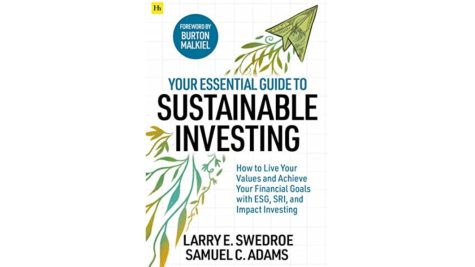Larry Swedroe’s new book explains “sustainable investing”
Published June 27, 2022
Since joining Buckingham Strategic Wealth in St. Louis, in 1996, Chief Research Officer Larry Swedroe has spent his time, talent, and energy educating investors on the benefits of evidence-based investing, by writing books explaining the science of investing in layman’s terms.
His latest book, “Your Essential Guide to Sustainable Investing” is available right now, and explains why Sustainable investing is booming and why the investment industry is fast approaching a point where one-third of global assets under management are invested with a sustainable objective.
Swedroe, 70, is a member of Congregation Shaare Emeth and a major contributor to the synagogue, the Jewish Federation, and the JCCA. He agreed to chat with the St. Louis Jewish Light about his new book, and how it can help anyone interested in this type of investing.
ADVERTISEMENT
How do you define “Sustainable Investing”

Sustainable investing is an umbrella term encompassing many forms although we can categorize most of them into three general categories: ESG, SRI, and impact. SRI, or socially responsible investing, was for decades the dominant term to describe sustainable investing. Just like the conventional investor, the socially responsible investor seeks to maximize total return for a given level of risk. However, given their personal values, they avoid investing in certain companies because of the products the companies make, or the way they conduct business.
Commonly ascribed to religious or deeply ethical investors, SRI strategies typically exclude problematic companies or even whole industries from portfolios. One oft-cited example is the Quakers, who published an investor guide more than 100 years ago, exhorting their followers to avoid any companies that profited from slave labor.
Environmental, social, and governance (ESG) criteria are a set of standards for a company’s operations that socially conscious investors use to screen potential investments. Environmental criteria consider how a company performs as a steward of nature. Social criteria examine how it manages relationships with employees, suppliers, customers, and the communities where it operates. Governance deals with a company’s leadership, executive pay, audits, internal controls, and shareholder rights.
ADVERTISEMENT
Impact investing differs from SRI in that it aims to generate specific beneficial social or environmental effects in addition to financial gains. For example, rather than donating food, the impact investor might contribute capital to start a farm. The food from the farm would feed the local community. Any profits would be reinvested to expand the business, thus feeding more people, creating more jobs, and increasing the resiliency of the community. In some cases, for-profit investment models are more sustainable and can be more impactful than philanthropic ones.
What about this topic interested you enough to turn it into your next book.
Sustainable investing has grown dramatically in the past decade. By 2020, environment, social, and governance (ESG) investing accounted for more than one-third of total assets under management in the United States, or about $17 trillion. The trend gained momentum in 2006 when the UN launched its Principles for Responsible Investment (PRI) in order to advance the integration of ESG. Then in 2017, the PRI launched its Blueprint for Responsible Investment, setting the direction of its work for the next 10 years. The blueprint stated that the PRI
Should focus its efforts on nine priority areas.
- Responsible Investors: We will strengthen, deepen and expand our core work to lead responsible investors in their pursuit of long-term value and to enhance alignment throughout the investment chain.
- Empower asset owners.
- Support investors incorporating ESG issues.
- Foster a community of active owners.
- Showcase leadership and increase accountability.
- Convene and educate responsible investors.
- Sustainable Markets: We will address unsustainable aspects of the markets that investors operate in, to achieve the economically efficient, sustainable global financial system that responsible investors and beneficiaries need.
- Challenge barriers to a sustainable financial system.
- Drive meaningful data throughout markets.
- A Prosperous World for All: We will enable signatories to improve the real world—now and in the future—encouraging investments that contribute to prosperous and inclusive societies for current and future generations.
- Champion climate action.
- Enable real-world impact aligned with the SDGs (sustainable development goals).
Observing the heightened interest in sustainable investing I noted that investors had to confront many issues. To address them the first part of our book provided in-depth definitions and explanations of the various terms used, providing clear distinctions between ESG, SRI, and impact investing. We then provided a history of how the movement has evolved from its initial religious-based origins. We move on to showing who is investing sustainably and why. the important historical context and cover who is doing it, and why. In the second part, we summarize the empirical research and what it says about risk and return. We cover what happens to firms’ cost of capital when they integrate sustainability, and what investors can expect in terms of performance from ESG and SRI strategies. That information allows investors to make informed decisions about how values driven investing can impact risk and return. The third part is our how-to guide, where we provide frameworks for choosing an asset allocation strategy and for selecting managers and funds.
Why should the everyday person, who is financially aware, but not a financial expert read this book, and what do you hope their takeaway will be?
Burton Malkiel, author of A Random Walk Down Wall Street, had this to say in his forward. “Amid all the hype concerning sustainable investing, there has been far too little attention paid to careful analysis of exactly what such investing really entails and what the evidence shows about its effectiveness. There is also far too little serviceable advice for investors who wish to invest sustainably. Adams and Swedroe fulfilled these needs with their highly readable and evidence-based guide for investors. Here they show what sustainable investing is, why one might want to do it, what financial returns have been achieved, and what its impact has been, as well as the pitfalls that exist. They also provide practical investment advice for individuals wishing to build ESG portfolios.
What was the most enjoyable part of writing this book?
The most enjoyable part was working with Sam Adams who I recruited to help write the book. As an expert on the history of the sustainable investment movement I learned a great deal and his passion, which comes across in his introduction to the book, was inspiring.
What was the biggest challenge in writing this book?
One of the biggest challenges for both investors and researchers is that there is no consistent definition or methodology to determine whether a company is operating in a sustainable manner or not because meritorious investments are in the eye of the beholder.
For example, the objectives of faith-based investment funds are far different from those that prize enhancing the goals of fair pay and inclusiveness. The most common and popular of such funds are those with explicit ESG objectives. But even then, the term means different things to different people, and it is difficult for investors to understand exactly what the ESG portfolios actually achieve.
To make matters worse, the ESG scores for different companies published by the professional rating services provided to portfolio managers differ materially. Correlations of ratings between different rating services are as low as 0.42. To put that number in perspective, the correlations between the bond ratings of S&P and Moody’s are more than 0.99. ESG raters cannot even agree when they are considering the same attribute, such as carbon intensity.
Within the electric utility industry, a company with one of the biggest carbon footprints is Xcel Energy. Xcel is ranked poorly by some raters because it generates a substantial share of its power from coal. But Xcel is the first U.S. utility committed to going 100 percent carbon-free by 2050 and is a leader in building wind-generation facilities. ESG ratings also differ markedly for companies for which carbon footprint is not a major factor.
Apple gets a high ESG rating of 73 percent from Refinitiv. S&P Global rates them only 23 percent and close to the bottom of their 22-company industry. Even on the identical ESG component of governance, ratings are not even close to one another. Sustainalytics considers Apple’s management among the most compliant with the best governance criteria, while MSCI considers Apple’s governance score second to last in its peer group
What’s next for you?
I am co-authoring a book with my friend Marat Molyboga on hedge fund investing.
Is there anything about this book, that I have not asked about, that you think people will find interesting?
Perhaps the most interesting and best news in the book is that the empirical evidence demonstrates that sustainable investors are, through the cash flows of their investments which impact the valuations of companies, positively impacting corporate behavior—firms with good corporate governance and lower emissions are positively recognized by shareholders with higher valuations (resulting in lower costs of capital, which provide a competitive advantage). In this way sustainable investors are able to influence corporate behavior by expressing their values through their investments.


















